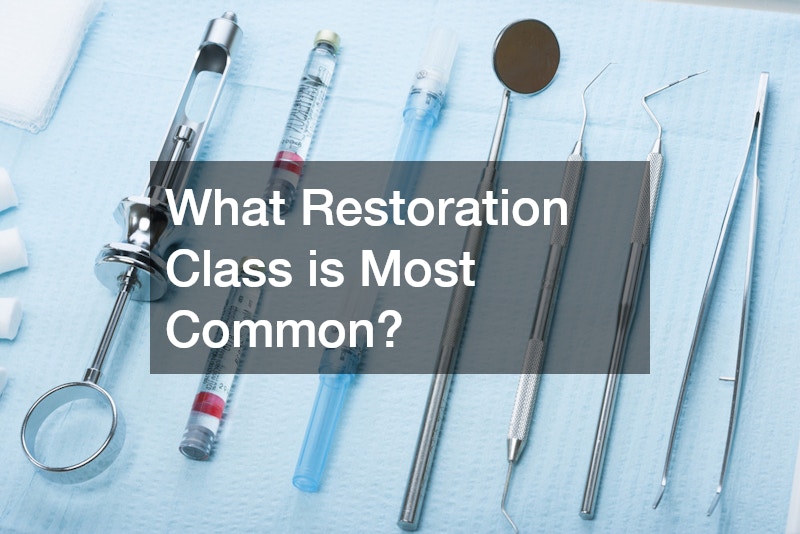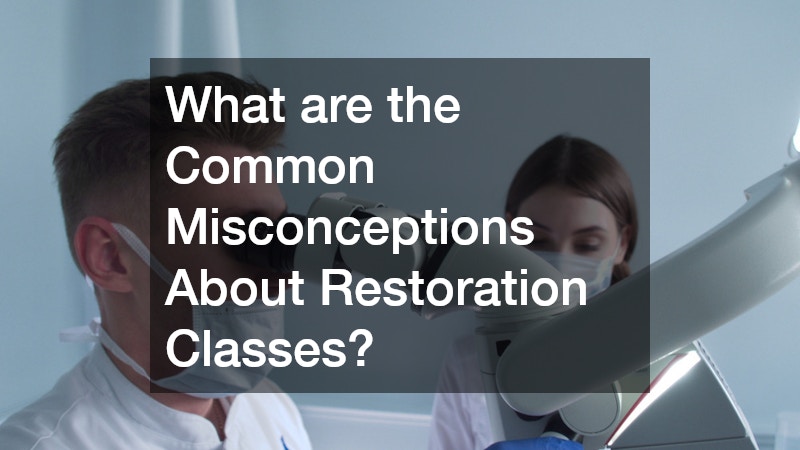Conquering Fear With Facts
Fear of the dentist is a common anxiety shared by millions around the globe. Whether it’s the sound of the drill, the fear of pain, or simply the unknown, dental anxiety often prevents people from seeking much-needed oral care. However, knowledge has the unique power to dismantle fear. When we take time to understand what we fear—like the procedures in dentistry—we equip ourselves with the ability to manage and overcome it. One such area that provides clarity and comfort is understanding the restoration classes in dentistry.
The classes of restoration categorize dental treatments based on the type and location of damage to the teeth. This structured classification helps patients understand what to expect from different procedures, removing ambiguity and making each visit to the dental office more predictable and less stressful. Just like knowing the steps before a surgery can calm a patient, knowing the restoration classes can reduce fear by demystifying dental procedures.
When people realize that restorative dental work doesn’t always mean painful or complex treatments, they start to view oral care in a more positive light. It can mean something as simple as a minor filling or teeth realignment. This article will explore how understanding the classes of restoration can help individuals overcome their fears, boost confidence, and embrace general dentistry as a proactive path to well-being.
What are Classes of Restoration?
In general dentistry, the term “classes of restoration” refers to the various categories of dental work designed to repair or restore damaged teeth. These classifications—originating from G.V. Black’s system—organize restorations based on the location and type of tooth decay or structural damage. The system comprises six primary classes:
Class I: Cavities in the pits and fissures of molars and premolars.
Class II: Decay on the proximal surfaces (sides) of molars and premolars.
Class III: Cavities on the proximal surfaces of incisors and canines without involving the incisal edge.
Class IV: Cavities on the proximal surfaces of incisors and canines involving the incisal edge.
Class V: Decay on the cervical third (near the gum line) of any tooth.
Class VI: Decay or wear on the incisal edges of anterior teeth or cusp tips of posterior teeth.
These classifications provide a standardized language for dental professionals, making it easier to diagnose and treat oral issues efficiently. For patients, understanding where their issue falls within these restoration classes gives them a clearer picture of what the procedure will involve.
How Do Classes of Restoration Help Overcome Fear?

When you walk into a dental office without knowing what might happen, your imagination can run wild with worst-case scenarios. However, when your dentist explains that your issue is a “Class I restoration,” and it simply means a small cavity in a molar that can be fixed with a quick filling, that clarity can be deeply reassuring. Understanding the classes of restoration creates a framework of expectations, which in turn minimizes anxiety.
Often, fear stems not from the pain itself, but from uncertainty. A clear explanation of the procedure based on the specific class helps you mentally prepare and emotionally adjust. For example, learning that Class V restorations typically don’t require drilling or anesthesia can significantly reduce your worry. By linking your condition to a specific class, the dentist breaks down a complex medical situation into something understandable and manageable.
Even more so, learning about the various classes through educational resources or during consultations empowers you to ask informed questions. This active participation in your own care not only builds trust with your dental provider but also transforms the experience from a fearful encounter into a collaborative journey toward better oral health.
Why Understanding is Key to Restoration?
Restorative dentistry focuses on returning your teeth to their proper function and aesthetics after damage from decay, trauma, or wear. It’s not just about fixing teeth—it’s about restoring confidence, health, and quality of life. Understanding the restoration classes helps patients see this specialty not as a source of fear, but as a solution.
Fear thrives in the unknown. The moment you understand that Class II restorations are common and straightforward procedures—usually requiring simple fillings—you begin to disarm that fear. With knowledge, you replace abstract dread with concrete facts. This allows you to shift your mindset from one of avoidance to one of proactive care.
Moreover, the insight into restoration classes can lead to better treatment decisions. When a dentist explains the difference between a Class III and a Class IV restoration, you can weigh your options more confidently, especially if cosmetic concerns are involved. Understanding enables you to take control of your oral health narrative instead of being a passive, fearful patient.
What Restoration Class is Most Common?

Among the many classes of restoration, Class I restorations are by far the most common in general dental practice. These typically involve cavities that develop in the pits and fissures of molars and premolars—areas where food particles and bacteria often accumulate. Because these surfaces are used most during chewing, they are more susceptible to decay, especially when proper oral hygiene isn’t maintained. These restorations are straightforward, minimally invasive, and usually completed in a single visit, which makes them less intimidating for patients.
Interestingly, the prevalence of Class I restorations is also indirectly linked to teeth alignment. Misaligned teeth can create hard-to-clean areas in the mouth, increasing the likelihood of decay in molars and other occlusal surfaces. Over time, improper alignment may lead to multiple Class I restorations or even escalate into more complex categories, like Class II, if decay spreads to adjacent surfaces. This highlights the interconnected nature of dental care, where orthodontic health directly impacts the restorative needs of a patient.
Understanding which class of restoration is most common helps normalize the experience of needing dental work. Knowing that a simple Class I restoration is a routine part of dental care—something nearly everyone undergoes—can make it far less intimidating. It removes the stigma or shame that sometimes accompanies a cavity diagnosis and instead reframes it as a standard step in maintaining oral health.
How to Identify Which Class of Restoration You Need?
Self-diagnosing isn’t recommended, but understanding the basic symptoms associated with each class can help you have more productive conversations with your dentist. For example, if you’re experiencing discomfort in the back of your mouth where your wisdom teeth reside, you may be dealing with a Class I or II restoration issue.
Your dentist will use visual inspections, X-rays, and sometimes 3D imaging to determine which class applies to your situation. During your visit, don’t hesitate to ask questions like, “What class is this restoration?” or “What does that mean for my treatment plan?” Engaging in the conversation gives you more control over your oral health journey.
By identifying the class of restoration early, you not only reduce treatment complexity but also avoid compounding issues that lead to more invasive procedures later. This proactive approach helps eliminate the sense of helplessness that often accompanies dental fear.
What are the Common Misconceptions About Restoration Classes?

A significant barrier to understanding is misinformation. Many believe that all restorations are painful or that they require multiple visits to a hospital or a hospital partner. The reality is far less daunting—most restorative procedures are quick, effective, and minimally invasive.
Another misconception is that all restorations are the same. In fact, each class has its unique challenges and treatment approaches. A Class VI restoration, which might involve the tip of a canine tooth, is vastly different from a Class II restoration on a molar. Understanding these distinctions helps patients realize that not every dental issue is major, which in turn calms the nerves.
Some patients also believe that once you need a restoration, the tooth is permanently weak. However, modern materials and techniques in restoration classes have evolved to be durable and natural-looking. They strengthen the tooth structure and enhance functionality, debunking myths about fragility and deterioration.
Can Understanding Restoration Classes Lead to Personal Growth?
Absolutely. Confronting and overcoming dental fear can spill over into other areas of life, such as public speaking, social interactions, or even diet choices. Understanding the restoration classes builds confidence, especially when combined with effective pain management strategies that dentists now commonly offer.
Knowledge about your oral health fosters a sense of empowerment. You transition from a fearful patient into an informed advocate for your well-being. This shift is a powerful form of personal growth—especially for those who have avoided dental visits for years due to anxiety.
Moreover, participating in your treatment journey deepens your appreciation for the resilience of your body and the value of self-care. In this sense, learning about restoration classes doesn’t just restore your smile—it restores your sense of agency and control.
What are Some Practical Applications of Restoration Classes?

In real-world applications, the classes of restoration play a vital role in planning treatments like a dental implant. For instance, if a Class II cavity was neglected and led to tooth loss, the restoration process might involve bone grafting, implant placement, and crown restoration. Understanding how the damage evolved through these classes gives context to the implant journey.
Dentists also use the classification system to decide which materials to use—composite resin for front teeth (Classes III or IV), and amalgam or ceramic for back teeth (Classes I and II). The process is meticulous, yet made efficient by knowing the class, saving patients time and reducing discomfort.
This system also aids in preventive care. If you know you’re prone to Class V issues—perhaps due to gum recession—you can take steps with your dentist to manage it early. This proactive application of knowledge makes treatment smoother and fear less overwhelming.
How Have Classes of Restoration Evolved Over Time?
The evolution of restoration classes mirrors advancements in dental science. Early classifications were rudimentary and focused primarily on visible decay. Today, technology allows for microscopic detection of damage, resulting in earlier and less invasive interventions. The rise of the cosmetic dentist has also expanded the purpose of restorations beyond function to include aesthetics.
Material technology has dramatically improved, moving from metal amalgams to biocompatible resins and ceramics. These materials not only restore teeth effectively but also blend seamlessly, enhancing patient satisfaction and reducing self-consciousness.
What was once a rigid classification system has now become more flexible, adapting to modern diagnostic tools and patient-centric care models. This evolution reflects a broader trend in healthcare: moving from reactive to proactive treatment, making it easier for patients to seek help without fear.
What are the Future Trends in Restoration Classes?
Looking ahead, the role of orthodontic consultants and AI in diagnostic dentistry is expanding. Future trends suggest that machine learning could soon help categorize restorations automatically, improving accuracy and reducing human error. This would further reduce patient fear by ensuring precise and minimally invasive treatments.
Another trend is the integration of personalized care. Based on a patient’s oral health history, genetics, and lifestyle, dentists may recommend customized restoration plans. Understanding classes of restoration will still be fundamental in this future, serving as the starting point for more tailored treatments.
Advancements in 3D printing and laser technology could revolutionize how restorations are performed. Procedures will become faster, less invasive, and more affordable—further removing the barriers of fear and inaccessibility.
Restorative Confidence
Understanding the classes of restoration is not merely about dental education—it’s about reclaiming power over your fears. By knowing what each class means and how it applies to your oral health, you replace anxiety with clarity, and hesitation with confidence. This shift in perspective can transform how you experience visits to the dentist.
In learning about these classes, you also gain insight into the broader field of restorative dentistry, equipping yourself to make informed decisions. Whether you’re dealing with misaligned teeth, wisdom tooth issues, or considering a dental implant, knowledge is your strongest ally. When fear dissipates, what remains is a healthier, more empowered you.
Ultimately, the journey through understanding classes of restoration is more than a clinical exercise—it’s a step toward personal growth. It teaches you that fear is often just a lack of information, and that healing begins with knowledge. Embrace that knowledge, and you’ll not only restore your smile but also renew your courage.


